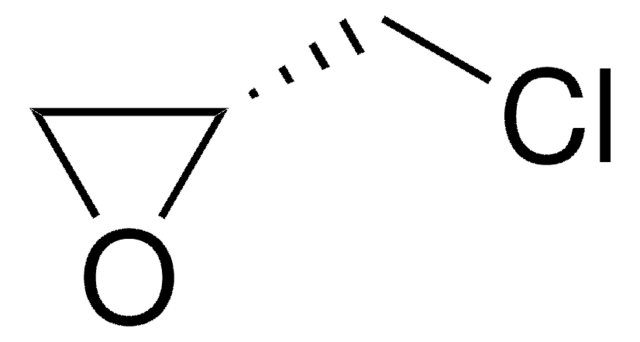45340
(±)-Epichlorohydrin
purum, ≥99% (GC)
Synonim(y):
(±)-2-(Chloromethyl)oxirane, 1-Chloro-2,3-epoxypropane
About This Item
Polecane produkty
gęstość pary
3.2 (vs air)
Poziom jakości
ciśnienie pary
13.8 mmHg ( 21.1 °C)
klasa czystości
purum
Próba
≥99% (GC)
temp. samozapłonu
779 °F
granice wybuchowości
21 %
zanieczyszczenia
≤0.1% water
kolor
APHA: ≤20
współczynnik refrakcji
n20/D 1.438 (lit.)
n20/D 1.438
tw
115-117 °C (lit.)
mp
−57 °C (lit.)
gęstość
1.183 g/mL at 25 °C (lit.)
Zastosowanie
agriculture
environmental
temp. przechowywania
room temp
ciąg SMILES
ClCC1CO1
InChI
1S/C3H5ClO/c4-1-3-2-5-3/h3H,1-2H2
Klucz InChI
BRLQWZUYTZBJKN-UHFFFAOYSA-N
Szukasz podobnych produktów? Odwiedź Przewodnik dotyczący porównywania produktów
Opis ogólny
Zastosowanie
- Pitfalls in the synthesis of fluorescent methotrexate oligopeptide conjugates.: Addresses challenges in synthesizing fluorescent methotrexate conjugates using Fmoc-Lys(Boc)-OH, aiming to optimize peptide-based drug delivery systems (Sebestyén et al., 2016).
- Fluoreometric behavior of a novel bis-acridine orange bound to double stranded DNA.: Explores the fluorescent properties of a bis-acridine compound integrated with Fmoc-Lys(Boc)-OH for potential applications in DNA interaction studies (Takenaka et al., 2003).
- Bis-naphthalene diimide exhibiting an effective bis-threading intercalating ability.: Investigates a bis-naphthalene diimide derivative, facilitated by Fmoc-Lys(Boc)-OH, demonstrating significant DNA intercalation, useful for gene therapy and molecular biology research (Nojima et al., 2003).
- Novel synthesis of a tetra-acridinyl peptide as a new DNA polyintercalator.: Details the synthesis of a new DNA polyintercalator using Fmoc-Lys(Boc)-OH, highlighting its potential to enhance molecular diagnostics and therapeutic strategies (Ueyama et al., 2000).
Hasło ostrzegawcze
Danger
Zwroty wskazujące rodzaj zagrożenia
Zwroty wskazujące środki ostrożności
Klasyfikacja zagrożeń
Acute Tox. 3 Dermal - Acute Tox. 3 Inhalation - Acute Tox. 3 Oral - Carc. 1B - Eye Dam. 1 - Flam. Liq. 3 - Repr. 2 - Skin Corr. 1B - Skin Sens. 1
Kod klasy składowania
3 - Flammable liquids
Klasa zagrożenia wodnego (WGK)
WGK 3
Temperatura zapłonu (°F)
82.4 °F
Temperatura zapłonu (°C)
28 °C
Środki ochrony indywidualnej
Faceshields, Gloves, Goggles, type ABEK (EN14387) respirator filter
Choose from one of the most recent versions:
Masz już ten produkt?
Dokumenty związane z niedawno zakupionymi produktami zostały zamieszczone w Bibliotece dokumentów.
Nasz zespół naukowców ma doświadczenie we wszystkich obszarach badań, w tym w naukach przyrodniczych, materiałoznawstwie, syntezie chemicznej, chromatografii, analityce i wielu innych dziedzinach.
Skontaktuj się z zespołem ds. pomocy technicznej











